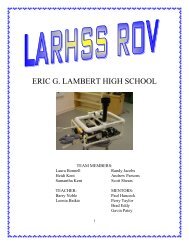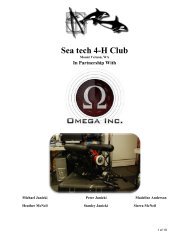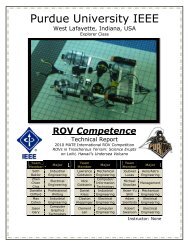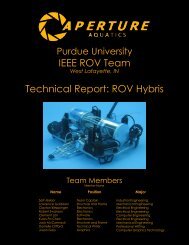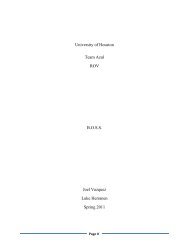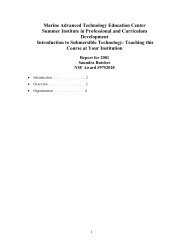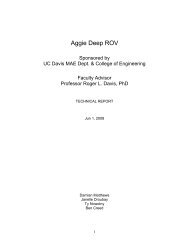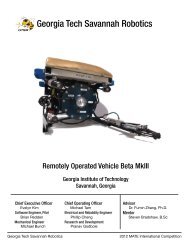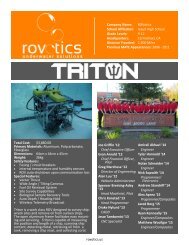Volume 19 • Number 3 • 2003 - the Marine Advanced Technology ...
Volume 19 • Number 3 • 2003 - the Marine Advanced Technology ...
Volume 19 • Number 3 • 2003 - the Marine Advanced Technology ...
Create successful ePaper yourself
Turn your PDF publications into a flip-book with our unique Google optimized e-Paper software.
THE JOURNAL OF MARINE EDUCATION<br />
<strong>Volume</strong> <strong>19</strong> <strong>•</strong> <strong>Number</strong> 3 <strong>•</strong> <strong>2003</strong><br />
OBJECTIVE<br />
The objective of this exercise is to solve <strong>the</strong> classification<br />
puzzles involving two animals. Both live in <strong>the</strong> area of<br />
Monterey Bay, California. The first is a deep ocean member of<br />
<strong>the</strong> molluscs that is ei<strong>the</strong>r an octopus or a squid. The second<br />
is a reptile that lives in <strong>the</strong> coastal sand dunes and is ei<strong>the</strong>r a<br />
lizard or a snake.<br />
ACTIVITY<br />
A. The Octopus/Squid whose binomial is Vampyroteuthis<br />
infernalis is found in deep ocean water that is low in<br />
oxygen. Very few have been brought up to <strong>the</strong> ocean<br />
surface and survived. Recently <strong>the</strong> biologists from MBARI<br />
(Monterey Bay Aquarium Research Institute) brought one<br />
up live from deep in <strong>the</strong> Monterey Submarine Canyon<br />
and were able to study it in a special aquarium.<br />
Characteristics for <strong>the</strong> Squid (decapods) and Octopuses<br />
(octopods) are:<br />
Squid (Decapods): have eight arms with suckers and two<br />
tentacles which are longer, elongated bodies and a<br />
pair of fins, funnel for locomotion.<br />
Octopuses (Octopods): have eight webbed arms that have<br />
rows of suckers, soft bodies, funnel for locomotion.<br />
A. Which two criteria would you use to put Vampyroteuthis in<br />
with <strong>the</strong> squid?<br />
B. Which two criteria would you use to put Vampyroteuthis in<br />
with <strong>the</strong> octopuses?<br />
C. Which two criteria would you use to put Vampyroteuthis in<br />
its own special group?<br />
D.Which category is <strong>the</strong> best fit? A, B, or C<br />
Why? Give three reasons.<br />
1.<br />
2.<br />
3.<br />
___<br />
B. The second taxonomic puzzle involves a reptile (Anniella<br />
pulchra) that burrows in <strong>the</strong> coastal sand dunes that<br />
surround Monterey Bay. Anniella looks like a snake and<br />
has some characteristics of lizards.<br />
The characteristics <strong>the</strong>y noticed were:<br />
1. A length of 30 cm (12 in.).<br />
2. Eight arms that are connected to form a tent-like web.<br />
3. Two very large bright blue eyes.<br />
4. Two fins that look like ears are located on <strong>the</strong> end far<strong>the</strong>st<br />
from <strong>the</strong> arms.<br />
5. Two long filaments that are much longer than <strong>the</strong> arms<br />
and can be extended from pockets between <strong>the</strong> arms on<br />
ei<strong>the</strong>r side.<br />
6. Each of <strong>the</strong> eight arms has a row of suckers and two rows<br />
of cirri (soft, fingerlike projections).<br />
7. A dark red body covered with photophores (light<br />
producing spots).<br />
8. When surprised it folded his web of arms back over its<br />
body and used <strong>the</strong> cirri for protection.<br />
9. The mouth in <strong>the</strong> center of webbed arms has a beak for<br />
biting food.<br />
10. Locomotion is by jet propulsion using its funnel to shoot<br />
out water and by flapping <strong>the</strong> fins.<br />
Characteristics of Anniella:<br />
1. No legs.<br />
2. A round body (it looks like a pencil) so that it can easily<br />
burrow in <strong>the</strong> sand.<br />
3. Moveable eye lids.<br />
4. Small smooth scales, that give it a polished look, are all<br />
over its body even along <strong>the</strong> belly.<br />
5. The lower jaw fits snugly with <strong>the</strong> upper jaw.<br />
6. A blunt tail so it can also burrow in <strong>the</strong> sand backwards.<br />
7. A length of 12 to 16 cm (41/2 to 6 1/2 in).<br />
8. The ability to detach its tail to escape predators.<br />
9. A silvery, tan or black colored back with thin dark lines<br />
running from nose to tail and a yellow belly.<br />
37



